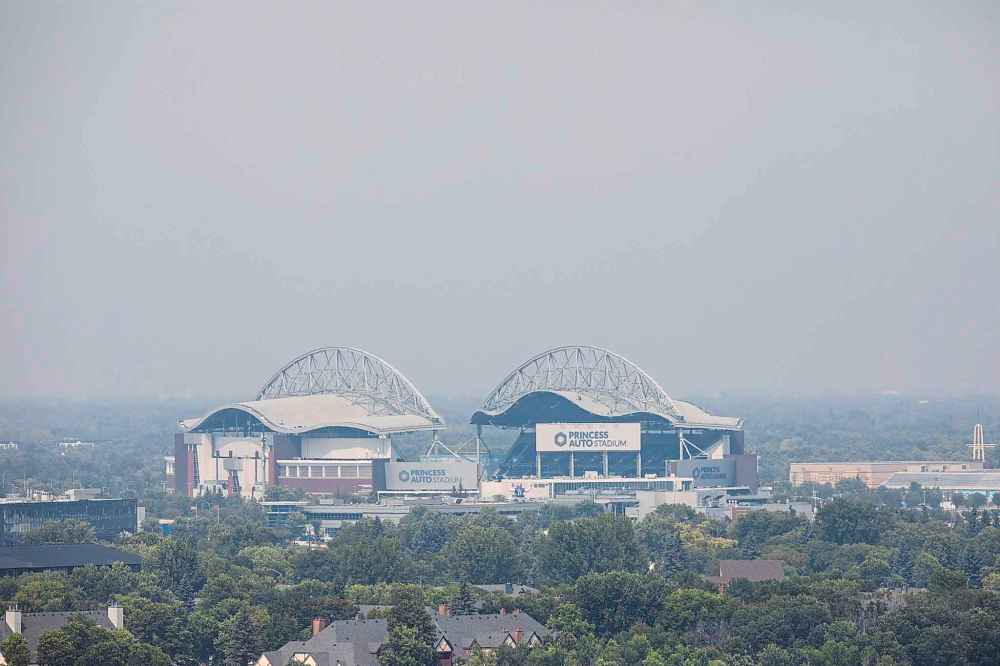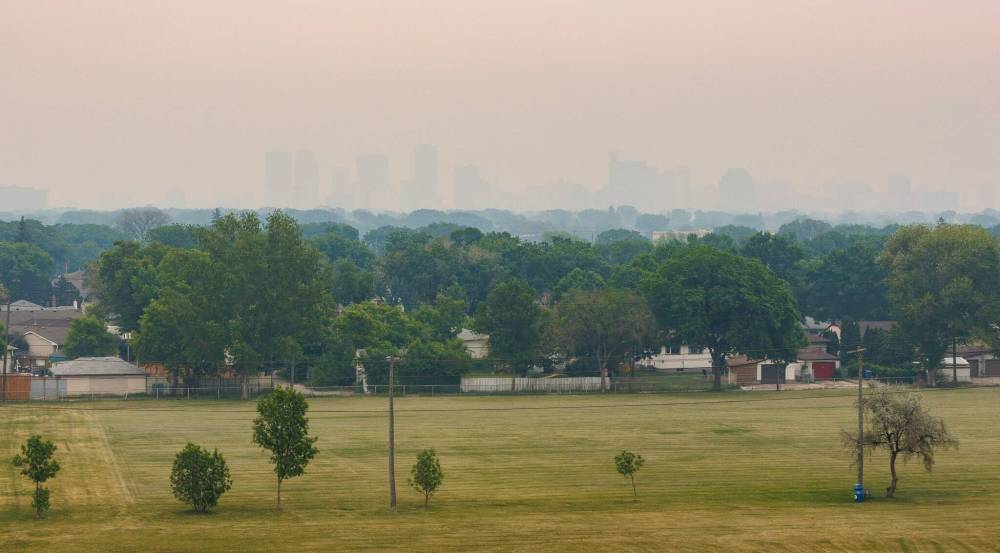An unavoidable future Air quality impact already changing landscape of outdoor sports in Manitoba
Read this article for free:
or
Already have an account? Log in here »
To continue reading, please subscribe:
Monthly Digital Subscription
$0 for the first 4 weeks*
- Enjoy unlimited reading on winnipegfreepress.com
- Read the E-Edition, our digital replica newspaper
- Access News Break, our award-winning app
- Play interactive puzzles
*No charge for 4 weeks then price increases to the regular rate of $19.00 plus GST every four weeks. Offer available to new and qualified returning subscribers only. Cancel any time.
Monthly Digital Subscription
$4.75/week*
- Enjoy unlimited reading on winnipegfreepress.com
- Read the E-Edition, our digital replica newspaper
- Access News Break, our award-winning app
- Play interactive puzzles
*Billed as $19 plus GST every four weeks. Cancel any time.
To continue reading, please subscribe:
Add Free Press access to your Brandon Sun subscription for only an additional
$1 for the first 4 weeks*
*Your next subscription payment will increase by $1.00 and you will be charged $16.99 plus GST for four weeks. After four weeks, your payment will increase to $23.99 plus GST every four weeks.
Read unlimited articles for free today:
or
Already have an account? Log in here »
Imagine you’re on a long run, dashing down a field trying to pass a soccer ball to your partner, or blocking someone to protect your quarterback.
Effort and energy are being used, you’re probably not breathing calmly through your nose, maybe you’re even huffing and puffing for air — as even the best of athletes sometimes have to after an intense workout or game.
In sports, effort and drive are praised and encouraged, and playing them can require significant cardiovascular exertion.

But that’s the problem, especially for outdoor sports and physical activities, when the air you’d usually be gasping for is no longer clean.
Across Manitoba and much of Canada, longer and more intense wildfire seasons leading to poor air quality have become a growing concern for outdoor sports, as the reality of regular smoky skies is transforming the outdoor sports landscape, from professional teams to local rec leagues.
Practices are being rescheduled, games postponed or cancelled, and people are forced to weigh whether to move forward with play against safety.
According to Madeleine Orr, assistant professor of sport ecology at the University of Toronto, there’s a significant difference between being outside when the air quality is poor, when you’re in a passive respiratory state, versus if you’re exercising and using your full lung capacity.
“The first thing is, when you exercise, you generally will bypass your nose and breathe through your mouth, right?” said Orr. “The problem with that, in the context of smoke, is it means you’re bypassing your nose, which is your body’s natural filtration system. That’s your body’s best mechanism for filtering out things like soot and smoke and sulphur and all these other things.”
“The second part is that when you breathe through your mouth, because you’re exercising, and as you exercise, you take in a higher volume of air, so you’re not only getting it unfiltered, you’re getting more of it all at once.”
Michael Koehle, a kinesiology professor at the University of British Columbia who researches the impact of air pollution on exercise, says there are only a few studies comparing people who are active during wildfire season to those who aren’t in terms of health outcomes. But, he notes, there’s an assumption that being active increases your dose of pollution, and with that, the expectation of greater chronic health effects.
“During a wildfire event, you’re exposed to bad air pollution, 24 hours a day, right?” said Koehle. “A lot of it can infiltrate into your home, and you’re breathing it throughout the day. In some sports where you’re breathing hard for long periods of time, say endurance running or cycling, then the actual dose of pollution is going to be higher.”
Wildfire smoke can have particles of soot, or black carbon, that, when exposed to, can lead to various health issues.
They may not show up right away, but it’s the long-term effects that are a concern, according to Koehle.
“That particulate matter can lead, in the long term, to increased incidence of respiratory disease, like a chronic obstructive pulmonary disease, or even things like lung cancer, and then cardiovascular disease like heart disease and stroke, and then also things like type two diabetes over time as well and even cognition problems,” said Koehle.
With the risks in mind, most outdoor sports organizations in Manitoba have developed frameworks to determine whether or not play should proceed.
The vast majority of sport organizations in Canada follow Environment Canada’s Air Quality Health Index (AQHI), which includes activity guidelines for both the general population and those considered at risk.
The Winnipeg Blue Bombers applied those guidelines just this week, cancelling a practice scheduled for Tuesday when the AQHI read 10+.
“I think the spectators probably will expect that more games will get cancelled and postponed.”–Michael Koehle
As per CFL/CFLPA policy, outdoor activities are suspended when the AQHI reaches eight or higher.
Football Manitoba, Soccer Manitoba and Rugby Manitoba all cancel play when the AQHI reads seven or higher, and have all faced cancellations and rescheduling this season.
Baseball Manitoba, which leaves cancellation decisions up to individual teams, outlines a similar framework, suggesting teams monitor athletes’ physical exertion levels when the AQHI is between seven and 10, and recommending cancellation or rescheduling if it rises above 10.
The Manitoba High School Athletic Association cancels events when the AQHI reaches eight or higher, which resulted in the cancellation of the Provincial Track and Field Championships in June.
A couple of weeks ago in Gimli, Man., the Sail West Regional Championships were cancelled due to poor air quality. Sail Manitoba president Eric Turner told CBC the cancellation has prompted the organization to draft an air quality policy moving forward.
The only professional outdoor sports team in Winnipeg that doesn’t follow an air quality policy is the Winnipeg Goldeyes, who have played when the AQHI Index read 10+ earlier in the summer.
“One particular baseball game doesn’t mean that you’re going to get demented and you know have lung cancer or something like that,” said Koehle. “But it’s just a cumulative effect of that, and it’s over time, and it takes time to develop. Often, most people feel okay while they’re playing baseball when the air quality health index is 10 or above, and it’s because it takes time for those health effects to manifest.”
As various organizations face cancellations this summer and implement or follow air quality policies for the first time, Orr says adaptation will need to remain part of the game plan moving forward.
“The simplest option is probably the best, and that probably just means we need to be more adaptive, right?” said Orr. “So, we can’t be as married to the schedule as we would like to be.”
But rescheduling is not without its challenges. For professional and elite teams, Orr says media contracts, team travel and large groups of spectators make changes difficult to co-ordinate.
And for recreational leagues, it’s often no easier.
“In Alberta and B.C., with wildfire-impacted communities, one of the things that we’re noticing over and over is, our kids are so scheduled these days,” said Orr. “That, when something gets disrupted, there’s not a whole lot of actual room to reschedule things. So if you’re talking about high school age kids, a lot of them have part-time jobs, lots of them are in multiple sports and activities.”
Orr adds that there are broader mental and social impacts when activities are cancelled due to smoke, and that managing these risks requires a careful balancing act.
“There’s a health impact for people, and there’s a mental health impact,” said Orr. “There’s a social element here that gets lost, especially when you have periods of smoke that are prolonged.”

Orr said that if you have the option to reschedule or move indoors when the air quality is poor, that’s the safest choice. But if teams choose to continue with activities, they can still make it safer by opting for a less intense practice instead of a game, or by shortening game times and including longer breaks to reduce heavy exertion, for example.
An advantage that professional teams do have is access to greater resources, including the ability to monitor air quality in real time, something smaller leagues may not be able to afford.
“These are not really, really expensive items,” said Orr. “We’re talking a couple hundred dollars for an air quality monitor, but like, your community soccer club doesn’t have that.”
With air quality varying drastically by location and often being difficult to predict, organizing future events without concern for wildfire smoke has become more of a challenge.
Take the 2026 FIFA World Cup for example, which runs from June 11 to July 19 and includes 13 matches in Canada, with seven in Vancouver and six in Toronto. The Canadian organizing committee has not yet publicly stated any air quality-related guidelines, leaving questions on how organizers will respond if air quality impacts the tournament.
Koehle says that, in general, mindsets will begin to shift around how sporting events are planned and experienced.
“I think the spectators probably will expect that more games will get cancelled and postponed,” said Koehle. “And so that may change the policies around the tickets in terms of refunds and rescheduling, and considerations.”
The most important thing, according to Koehle, is education around the long-term health risks of wildfire smoke exposure, and a buy-in to a changed outdoor sports world.
“I think that’s the challenge for the sporting organizations is making sure everyone’s aware enough,” Koehle said. “And also managing the disappointments and the consequences when things are pulled.”
zoe.pierce@freepress.mb.ca




